Effect of Titanium Mandible Implant on the Electric Field and SAR Distribution Caused by Mobile Phone Within the User’s Head
Abstract
1. Introduction
2. Methodology
2.1. Numerical Method
2.2. 3D Head Model
2.3. 3D Models of Titanium Plates and Screws
2.4. 3D Model of a Mobile Phone
3. Results
3.1. Electric Field Distribution Inside the User’s Head
3.2. Distribution of SAR Values Within the Model of the Head of a User
3.3. Impact of the Face-to-Phone Distances on the Electric Field and SAR Distribution in the Implant Vicinity
4. Conclusions
Author Contributions
Funding
Data Availability Statement
Conflicts of Interest
References
- Alpert, B.; Seligson, D. Removal of asymptomatic bone plates used for orthognathic surgery and facial fractures. J. Oral Maxillofac. Surg. 1996, 54, 618–621. [Google Scholar] [CrossRef] [PubMed]
- Rae, T. The biological response to titanium and titanium-aluminium-vanadium alloy particles. I. Tissue culture studies. Biomaterials 1986, 7, 30–36. [Google Scholar] [CrossRef] [PubMed]
- Haug, R.H. Retention of asymptomatic bone plates used for orthognathic surgery and facial fractures. J. Oral Maxillofac. Surg. 1996, 54, 611–617. [Google Scholar] [CrossRef]
- Katou, F.; Andoh, N.; Motegi, K.; Nagura, H. Immuno-inflammatory responses in the tissue adjacent to titanium miniplates used in the treatment of mandibular fractures. J. Cranio-Maxillo-Facial Surg. Off. Publ. Eur. Assoc. Cranio-Maxillo-Facial Surg. 1996, 24, 155–162. [Google Scholar] [CrossRef]
- Neumann, A.; Kevenhoerster, K. Biomaterials for craniofacial reconstruction. GMS Curr. Top. Otorhinolaryngol. Head Neck Surg. 2009, 8, Doc08. [Google Scholar] [CrossRef]
- Whittow, W.G.; Edwards, R.M.; Panagamuwa, C.J.; Vardaxoglou, J.C. Effect of tongue jewellery and orthodontist metallic braces on the SAR due to mobile phones in different anatomical human head models including children. In Proceedings of the Loughborough Antennas and Propagation Conference, Loughborough, UK, 17–18 March 2009; pp. 293–296. [Google Scholar] [CrossRef]
- Jovanović, B.D.; Krasić, D.D.; Stanković, B.V.; Cvetković, N.N.; Vucković, D.D. Electric field and SAR distribution in the vicinity of orthodontic brace exposed to the cell phone radiation. ACES J. 2019, 34, 1904–1914. [Google Scholar]
- Jovanović, D.; Krasić, D.; Cvetković, N.; Vucković, D.; Stanković, V. Electric Field and SAR Distribution in the Vicinity of Dental Implants Exposed to the Cell Phone Electromagnetic Radiation. COMPEL Int. J. Comput. Math. Electr. Electron. Eng. 2023, 45, 1052–1067. [Google Scholar] [CrossRef]
- Mortazavi, S.M.J.; Paknahad, M.; Khaleghi, I.; Eghlidospour, M. Effect of radiofrequency electromagnetic fields (RF-EMFS) from mobile phones on nickel release from orthodontic brackets: An in vitro study. Int. Orthod. 2018, 16, 562–570. [Google Scholar] [CrossRef]
- Fujii, Y. Gold alloy dental inlay for preventing involuntary body movements caused by electromagnetic waves emitted by a cell phone. Open J. Antennas Propag. 2014, 2, 37–43. [Google Scholar] [CrossRef][Green Version]
- Chou, C.K.; McDougall, J.A.; Chan, K.W. RF heating of implanted spinal fusion stimulator during magnetic resonance imaging. IEEE Trans. Biomed. Eng. 1997, 44, 367–373. [Google Scholar] [CrossRef]
- Hocking, B.; Joyner, K.H.; Fleming, H.J. Implanted medical devices in workers exposed to radio-frequency radiation. Scand. J. Work. Environ. Health 1991, 17, 1–6. [Google Scholar] [CrossRef] [PubMed][Green Version]
- Fleming, A.H.J.; Anderson, V.; Rowley, J.R. Computational estimate of the frequency response of metallic implants in biological tissues exposed to RF fields. In Proceedings of the ACES Annual Review of Progress in Applied Computational Electromagnetics, Monterey, CA, USA, 16–20 March 1999. [Google Scholar]
- Cooper, J.; Hombach, V. Increase in specific absorption rate in human heads arising from implantations. Electron. Lett. 1996, 32, 2217–2219. [Google Scholar] [CrossRef]
- Foster, K.R.; Goldberg, R.; Bonsignore, C. Heating of cardiovascular stents in intense radio frequency magnetic fields. Bioelectromagnetics 1999, 20, 112–116. [Google Scholar] [CrossRef]
- Crouzier, D.; Selek, L.; Martz, B.A.; Dabouis, V.; Arnaud, R.; Debouzy, J.-C. Risk assessment of electromagnetic fields exposure with metallic orthopedic implants: A cadaveric study. Orthop. Traumatol. Surg. Res. 2012, 98, 90–96. [Google Scholar] [CrossRef][Green Version]
- Turgut, A.; Engiz, B.K. Analyzing the SAR in human head tissues under different exposure scenarios. Appl. Sci. 2023, 13, 6971. [Google Scholar] [CrossRef]
- Christopher, B.; Mary, S.; Khandaker, M.U.; Jojo, P.J. Empirical study on specific absorption rate of head tissues due to induced heating of 4G cell phone radiation. Radiat. Phys. Chem. 2021, 178, 108910. [Google Scholar] [CrossRef]
- Tian, R.; Wu, Y.-Q.; Lu, M.; Miao, X.-F. Specific absorption rate and temperature distributions in the human head with implanted deep brain stimulation subjected to mobile phone electromagnetic radiation. Electronics 2023, 12, 4389. [Google Scholar] [CrossRef]
- Benova, M.; Mydlova, J.; Psenakova, Z.; Smondrk, M. SAR evaluation in human head models with cochlear implant near PIFA antenna inside a railway vehicle. In Formation Technology in Biomedicine; Advances in Intelligent Systems and Computing; Springer: Cham, Switzerland, 2021; Volume 1186. [Google Scholar] [CrossRef]
- Virtanen, H.; Keshvari, J.; Lappalainen, R. The effect of authentic metallic implants on the SAR distribution of the head exposed to 900, 1800 and 2450 MHz dipole near field. Phys. Med. Biol. 2007, 52, 1221–1236. [Google Scholar] [CrossRef]
- Živaljević, D.; Jovanović, D.; Krasić, D.; Cvetković, N.; Petković, B. Impact of titanium cranial implants on the electric field and SAR distribution induced by mobile phones within the user’s head. Electronics 2024, 13, 4551. [Google Scholar] [CrossRef]
- Yi, M.; Wu, B.; Zhao, Y.; Su, T.; Chi, Y. Safety assessment and uncertainty quantification of electromagnetic radiation from mobile phones to the human head. Appl. Sci. 2023, 13, 8107. [Google Scholar] [CrossRef]
- Ramachandran, T.; Faruque, M.R.I.; Islam, M.T. Specific absorption rate reduction for sub-6 frequency range using polarization dependent metamaterial with high effective medium ratio. Sci. Rep. 2022, 12, 1803. [Google Scholar] [CrossRef] [PubMed]
- CST Microwave Studio, version 2012; Computer Simulation Technology: Framingham, MA, USA, 2012.
- Clemens, M.; Weiland, T. Discrete electromagnetism with the finite integration technique. Prog. Electromagn. Res. 2001, 32, 65–87. [Google Scholar] [CrossRef]
- Toro, J.; Choukiker, Y.K. Design and analysis of meanderline PIFA antenna with MIMO system for mobile handheld device. In Proceedings of the International Conference on Trends in Electronics and Informatics, Tirunelveli, India, 11–12 May 2017; pp. 1061–1065. [Google Scholar]
- IEEE C95.3-2002; IEEE Recommended Practice for Measurements and Computations of Radio Frequency Electromagnetic Fields with Respect to Human Exposure to Such Fields, 100 kHz–300 GHz. IEEE: New York, NY, USA, 2002. [CrossRef]
- Ebrahimi-Ganjeh, M.A.; Attari, A.R. Interaction of dual band helical and PIFA handset antennas with human head and hand. Prog. Electromagn. Res. 2007, 77, 225–242. [Google Scholar] [CrossRef]
- IEC/IEEE 62704-1; IEC/IEEE International Standard-Determining the Peak Spatial-Average Specific Absorption Rate (SAR) in the Human Body from Wireless Communications Devices, 30 MHz to 6 GHz-Part 1: General Requirements for Using the Finite-Difference Time-Domain (FDTD) Method for SAR Calculations; 27 October 2017. IEEE Standards Association: Piscataway, NJ, USA, 2017; pp. 1–86.
- Available online: http://demo.paragraf.rs/demo/combined/Old/t/t2009_12/t12_0270.htm (accessed on 5 September 2020).
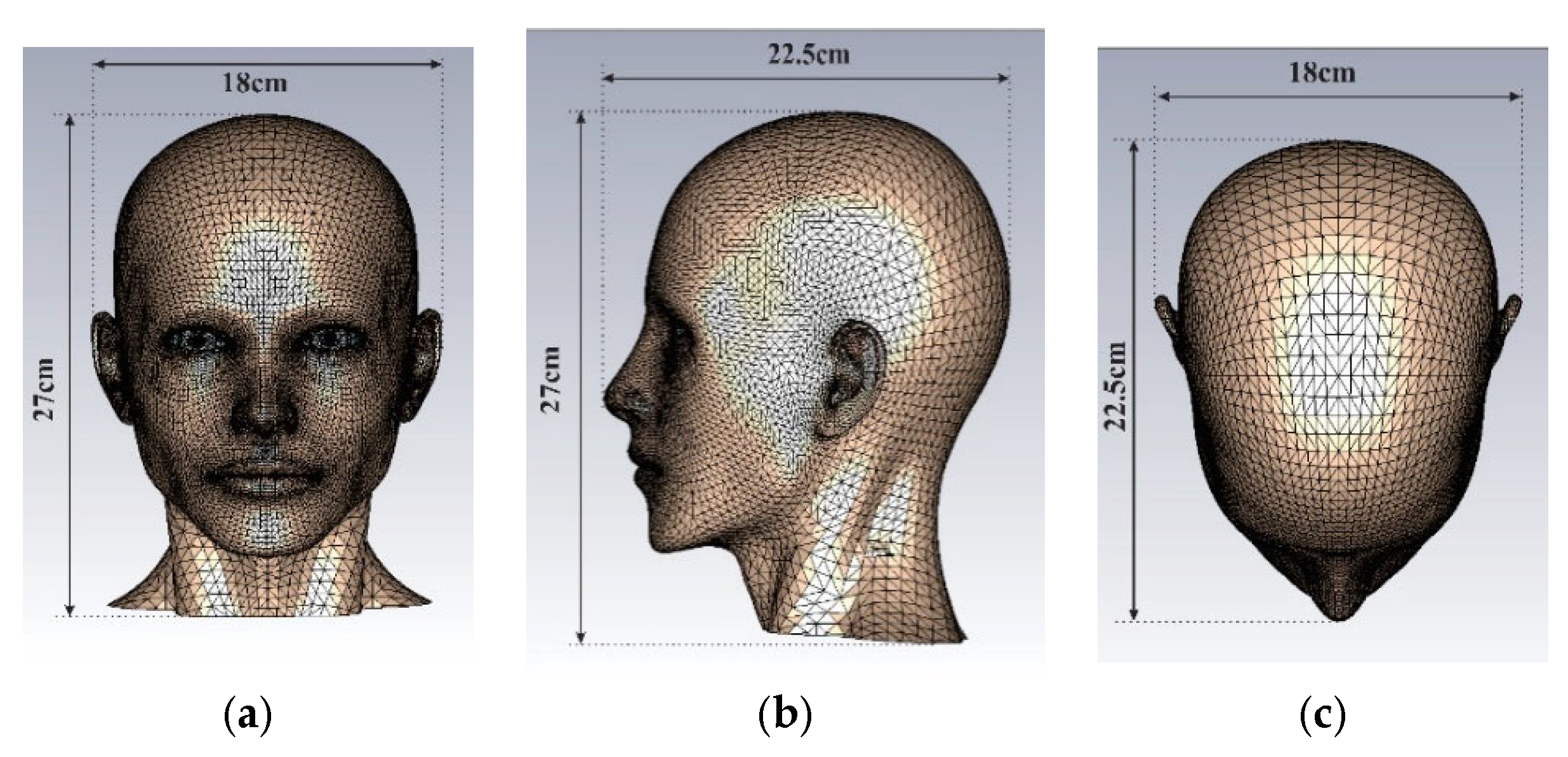


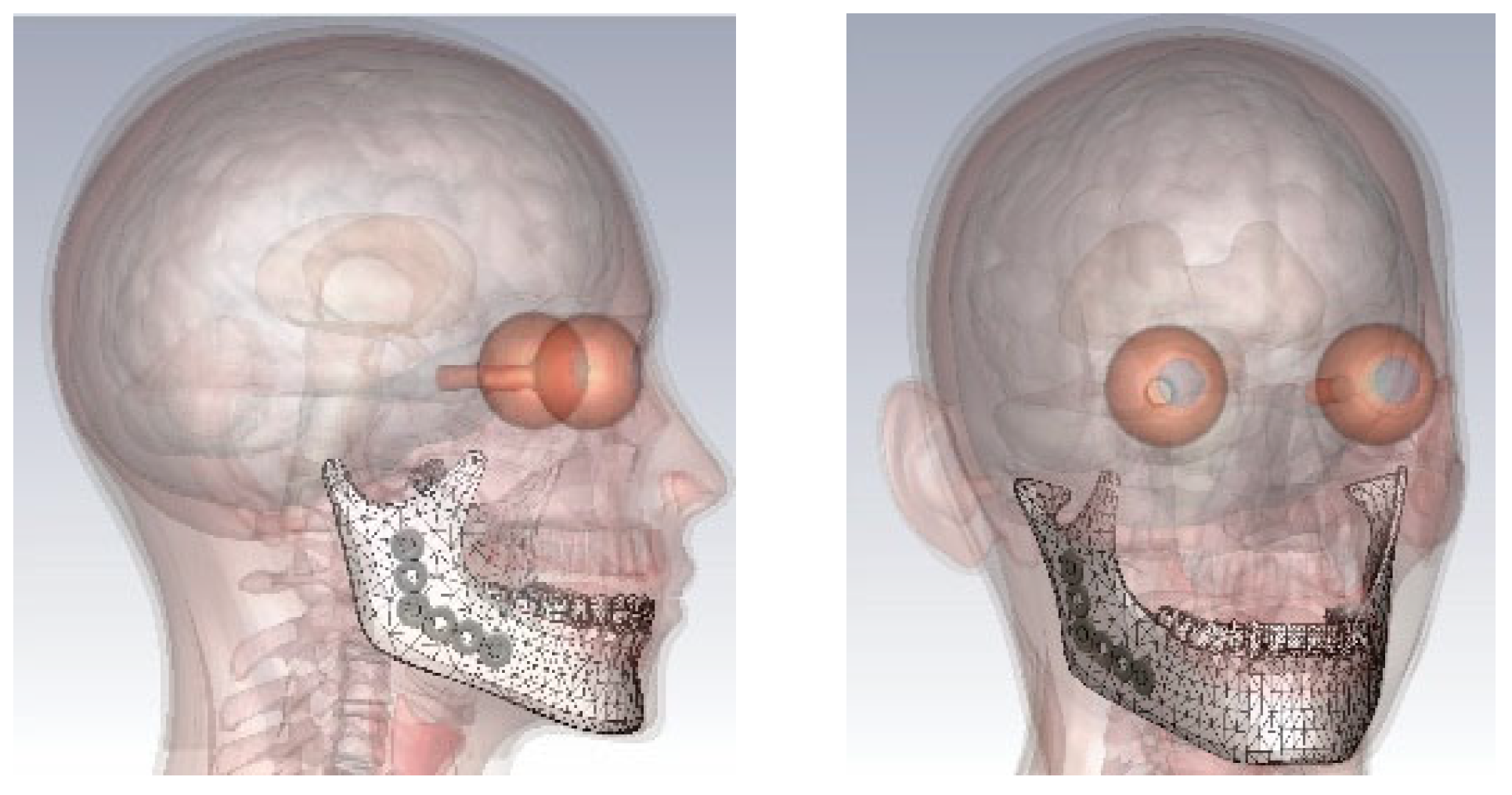


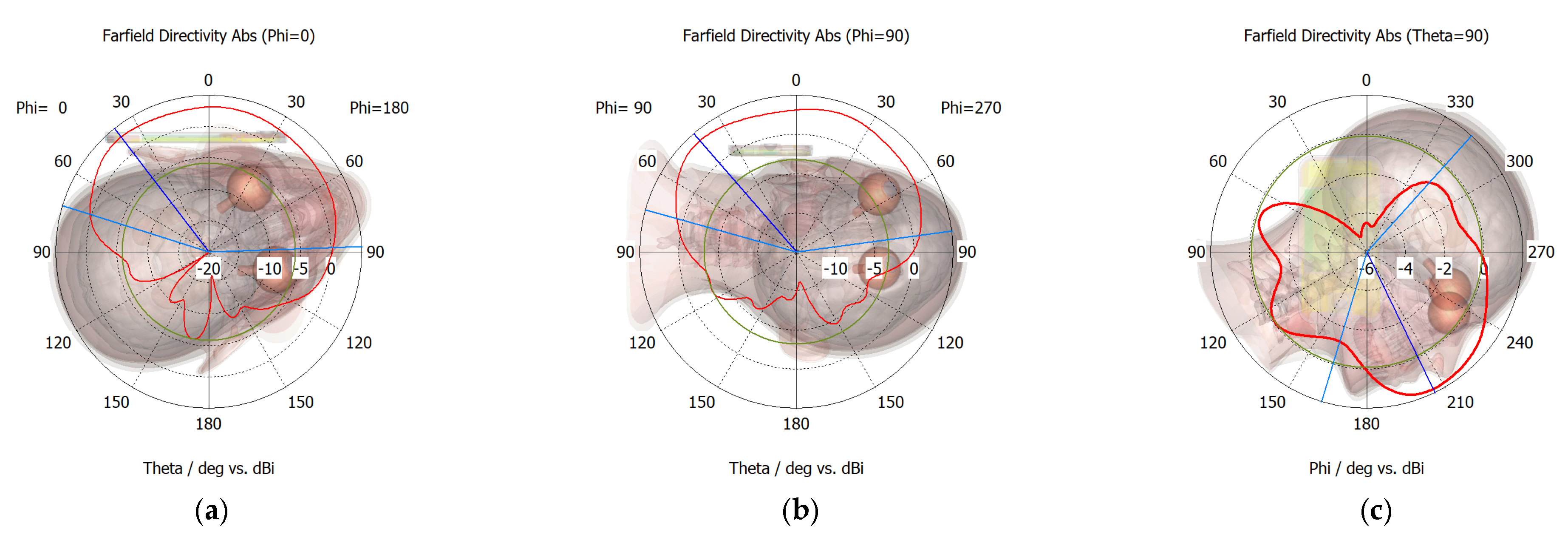
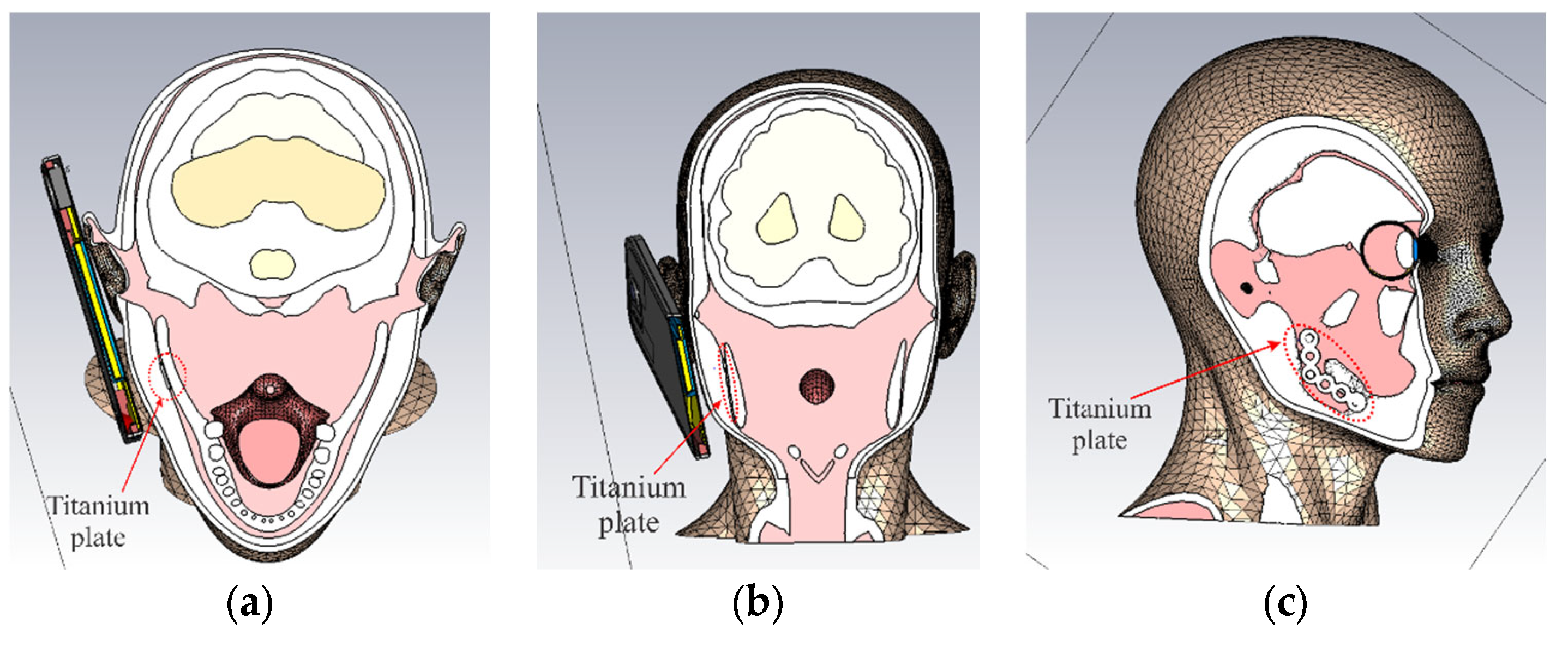



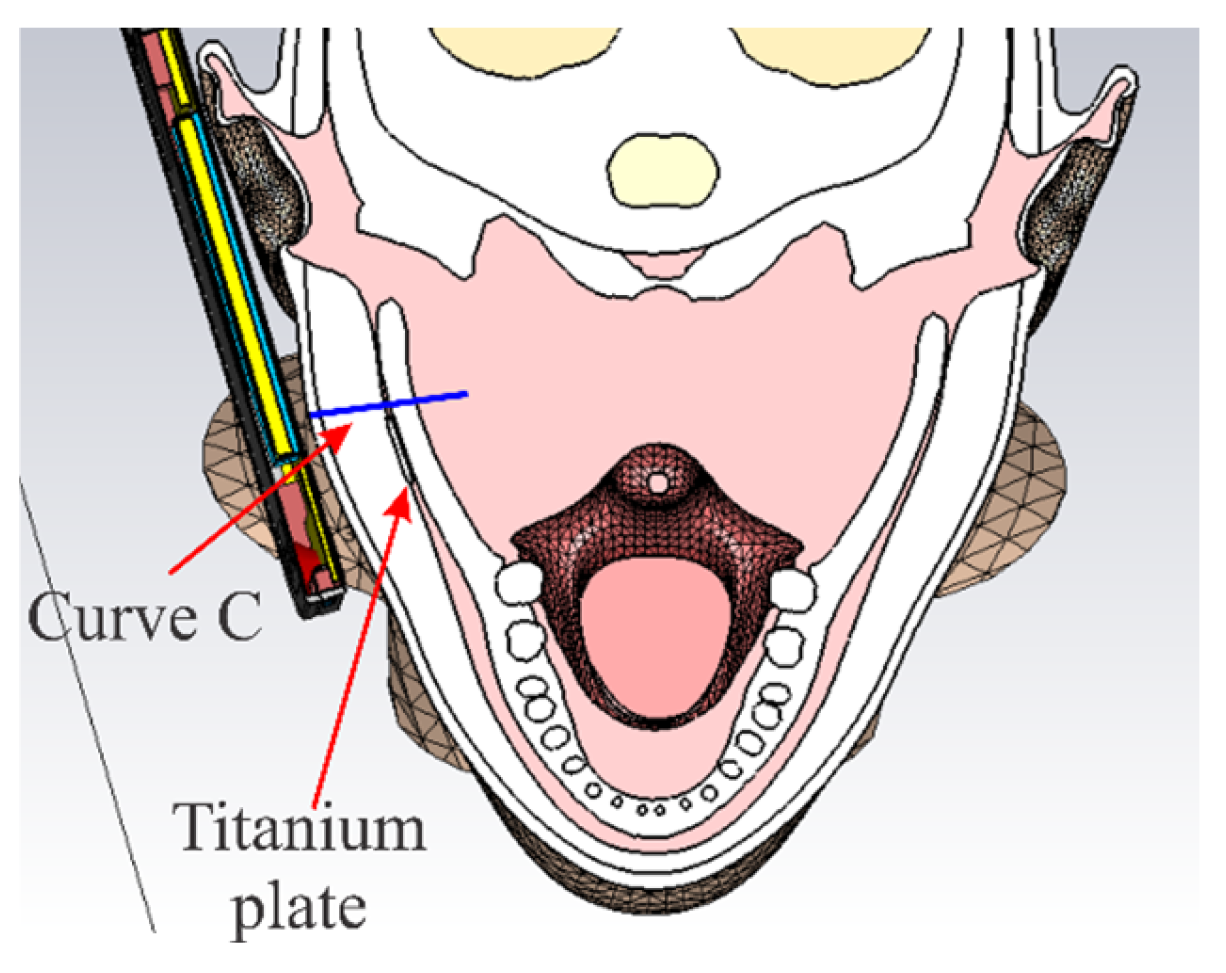


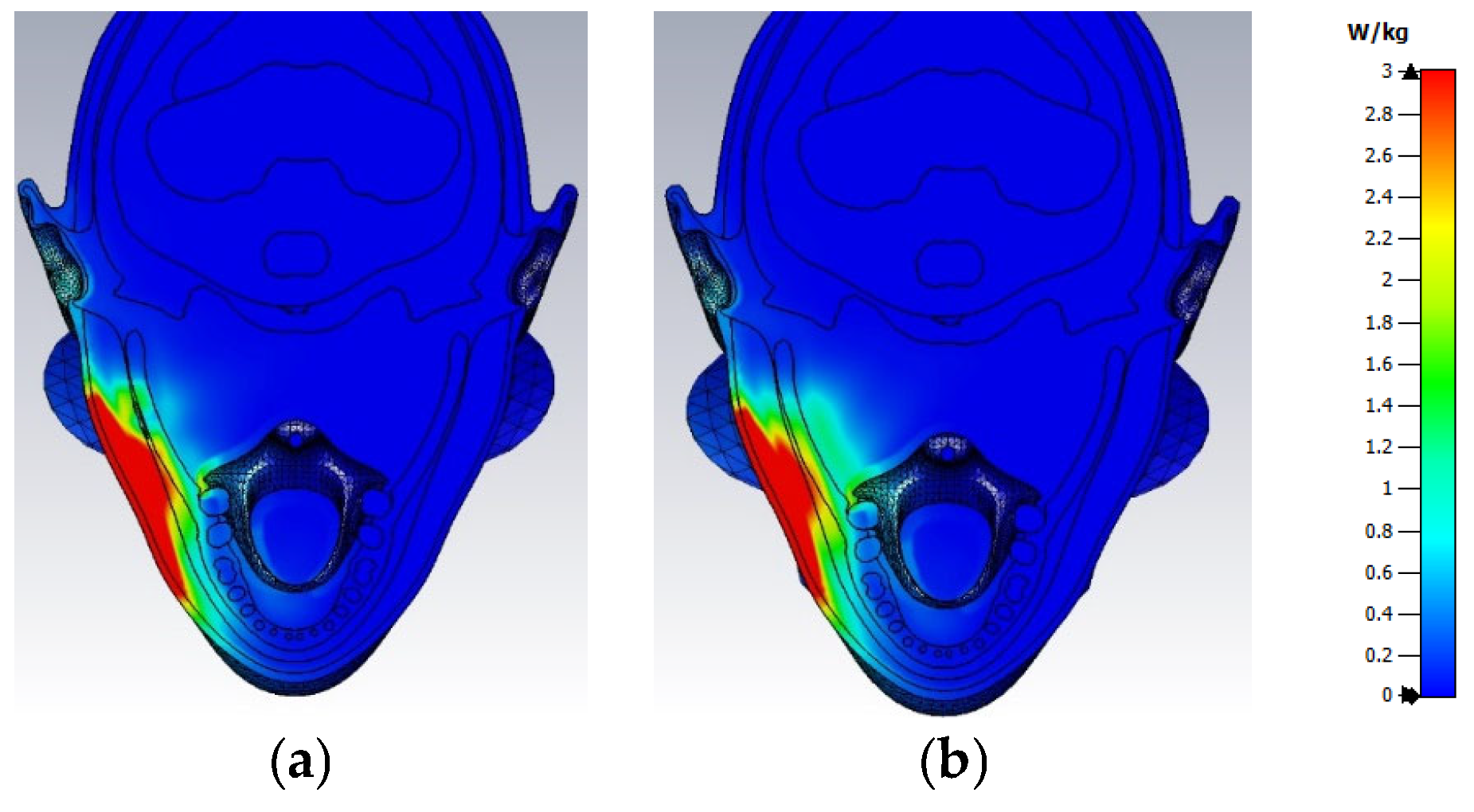
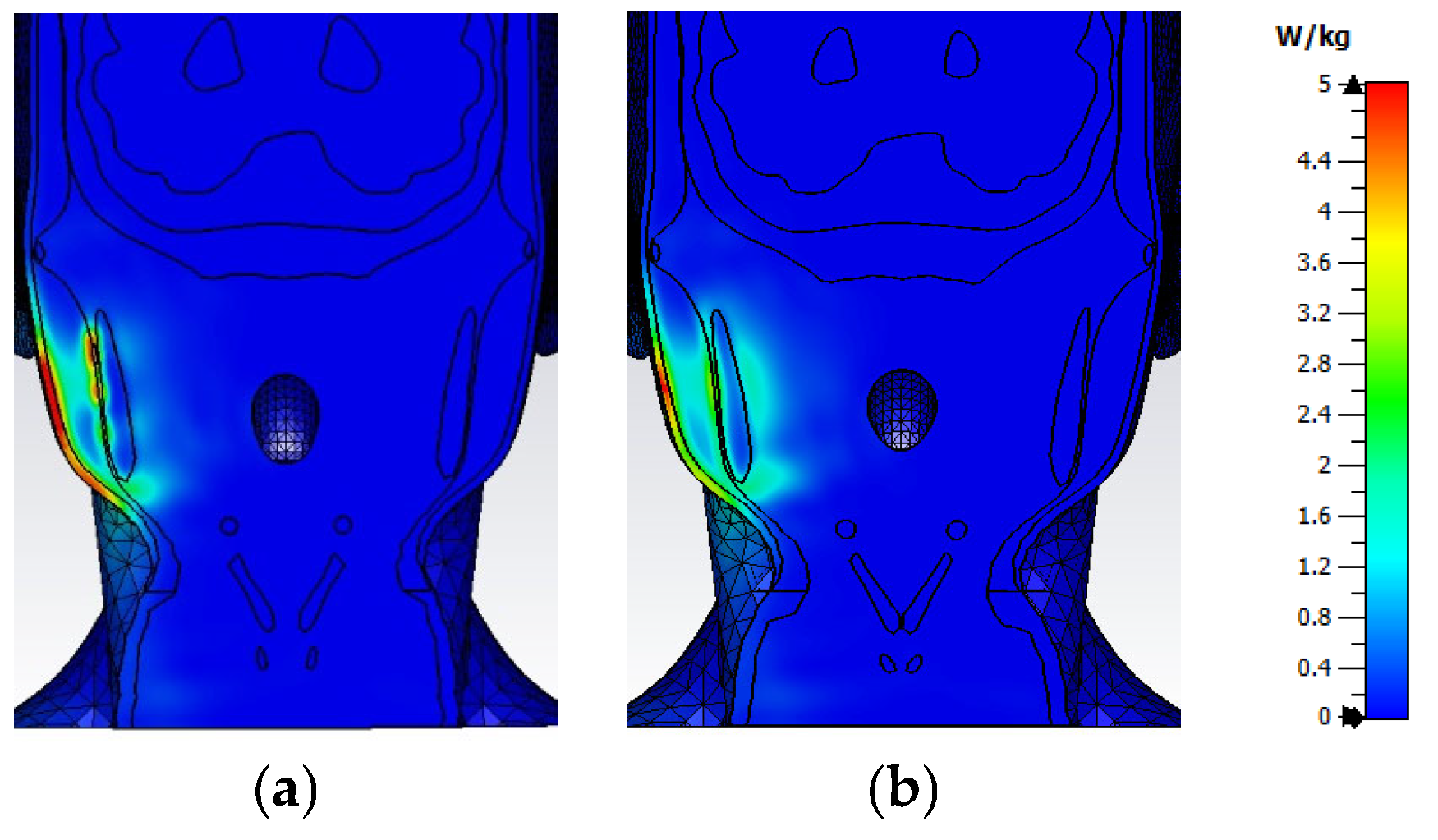
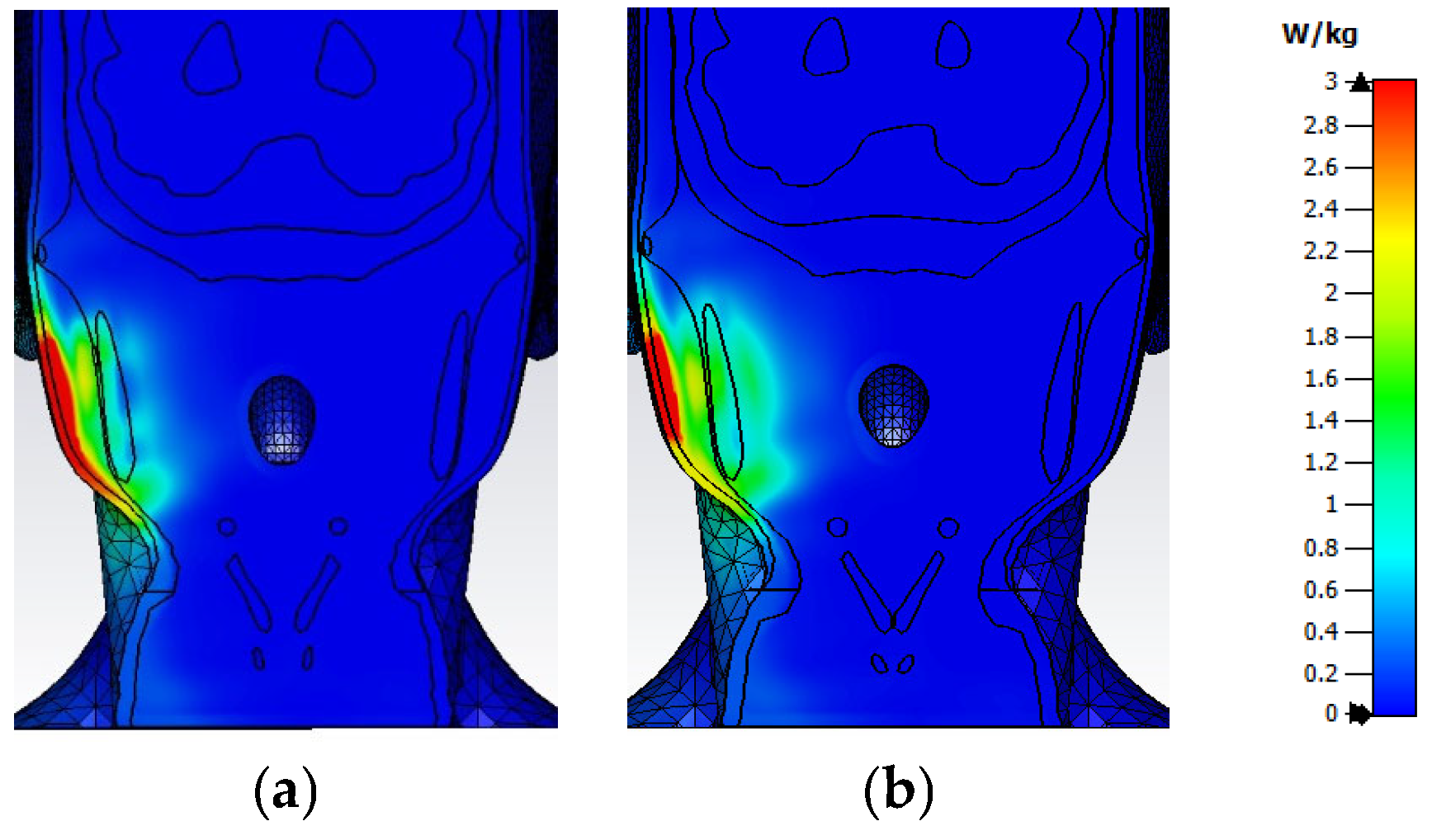
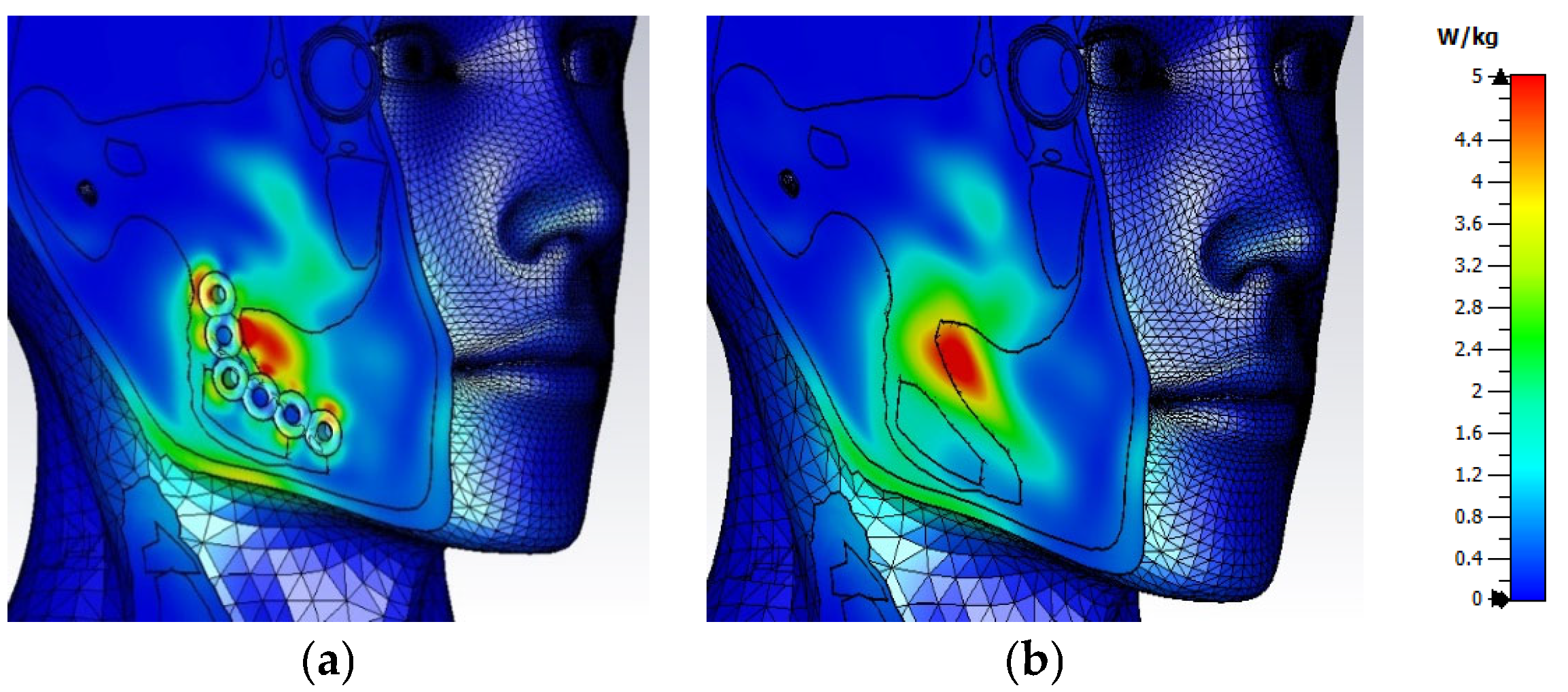
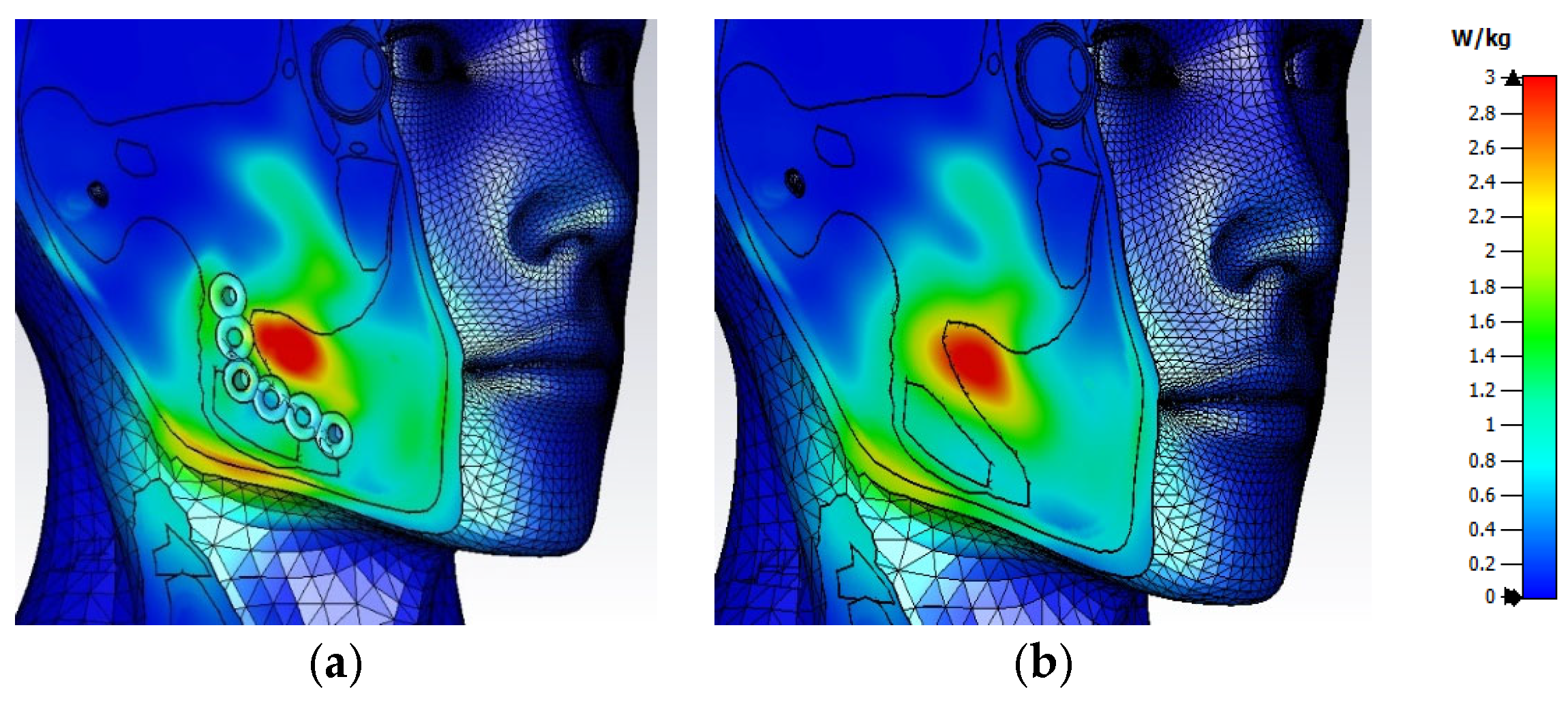


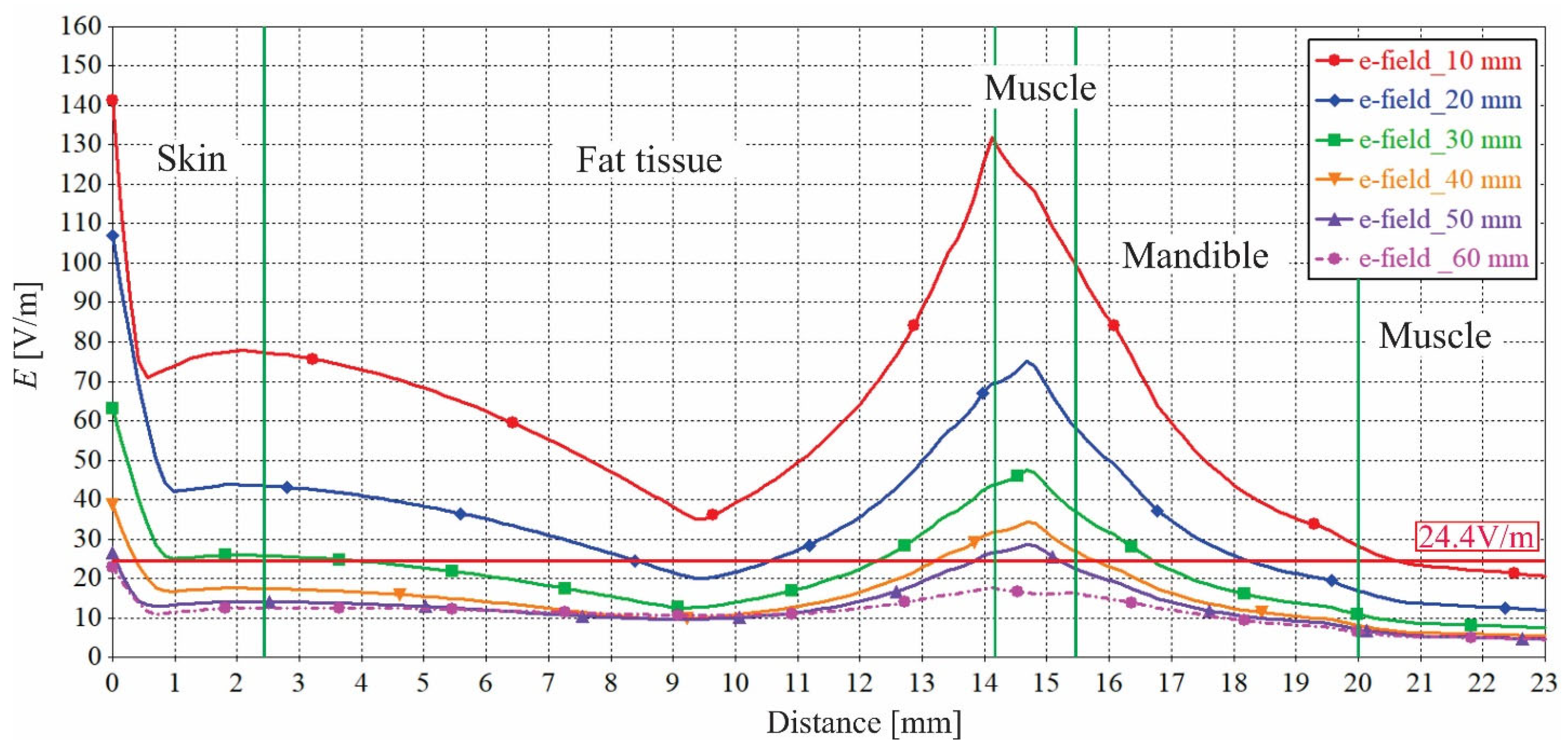

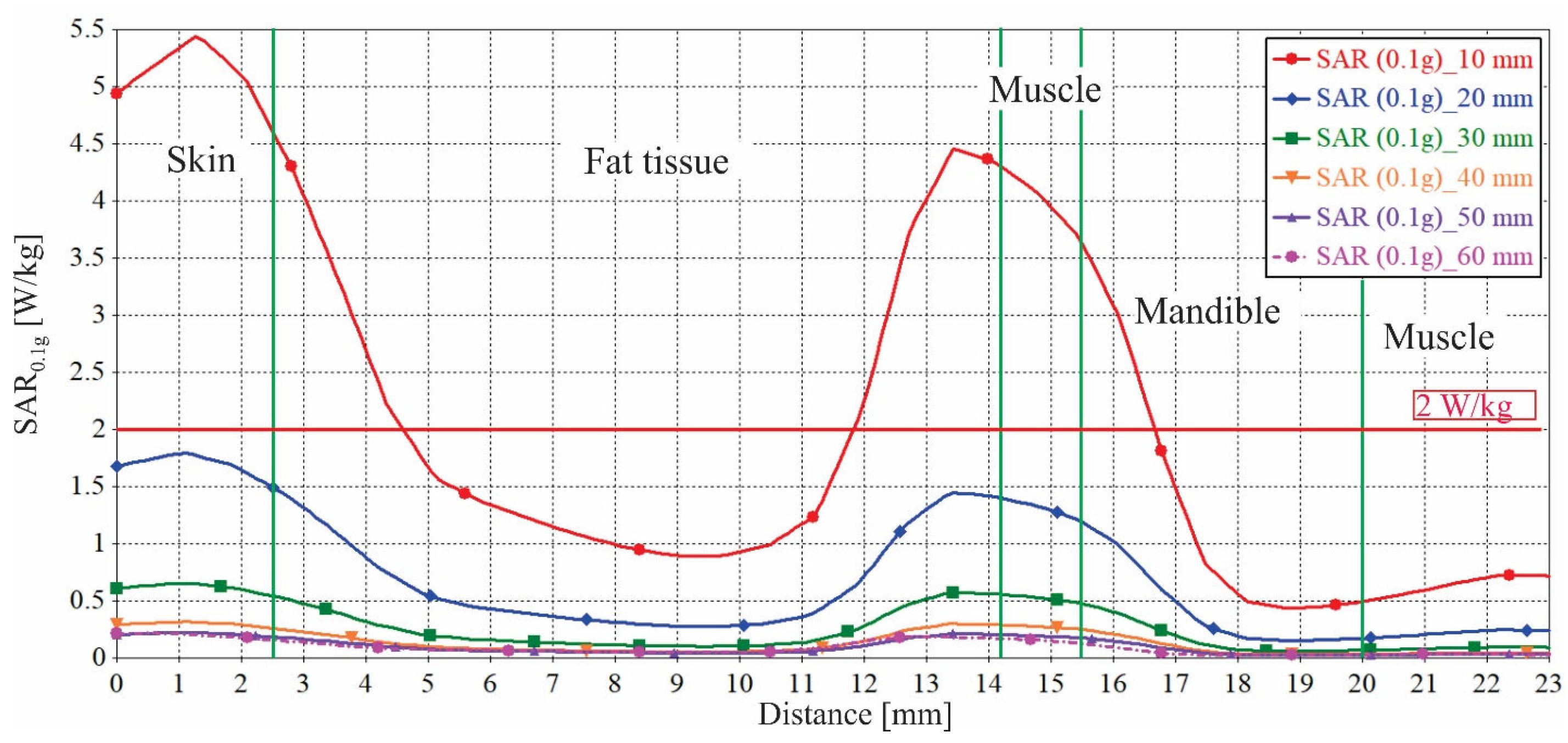
Disclaimer/Publisher’s Note: The statements, opinions and data contained in all publications are solely those of the individual author(s) and contributor(s) and not of MDPI and/or the editor(s). MDPI and/or the editor(s) disclaim responsibility for any injury to people or property resulting from any ideas, methods, instructions or products referred to in the content. |
© 2025 by the authors. Licensee MDPI, Basel, Switzerland. This article is an open access article distributed under the terms and conditions of the Creative Commons Attribution (CC BY) license (https://creativecommons.org/licenses/by/4.0/).
Share and Cite
Jovanović, D.; Krasić, D.; Cvetković, N.; Stanković, V.; Živaljević, D.; Petković, B. Effect of Titanium Mandible Implant on the Electric Field and SAR Distribution Caused by Mobile Phone Within the User’s Head. Electronics 2025, 14, 2096. https://doi.org/10.3390/electronics14112096
Jovanović D, Krasić D, Cvetković N, Stanković V, Živaljević D, Petković B. Effect of Titanium Mandible Implant on the Electric Field and SAR Distribution Caused by Mobile Phone Within the User’s Head. Electronics. 2025; 14(11):2096. https://doi.org/10.3390/electronics14112096
Chicago/Turabian StyleJovanović, Dejan, Dragan Krasić, Nenad Cvetković, Vladimir Stanković, Dragana Živaljević, and Bojana Petković. 2025. "Effect of Titanium Mandible Implant on the Electric Field and SAR Distribution Caused by Mobile Phone Within the User’s Head" Electronics 14, no. 11: 2096. https://doi.org/10.3390/electronics14112096
APA StyleJovanović, D., Krasić, D., Cvetković, N., Stanković, V., Živaljević, D., & Petković, B. (2025). Effect of Titanium Mandible Implant on the Electric Field and SAR Distribution Caused by Mobile Phone Within the User’s Head. Electronics, 14(11), 2096. https://doi.org/10.3390/electronics14112096





